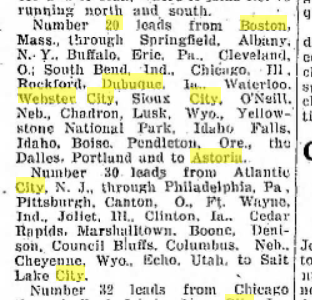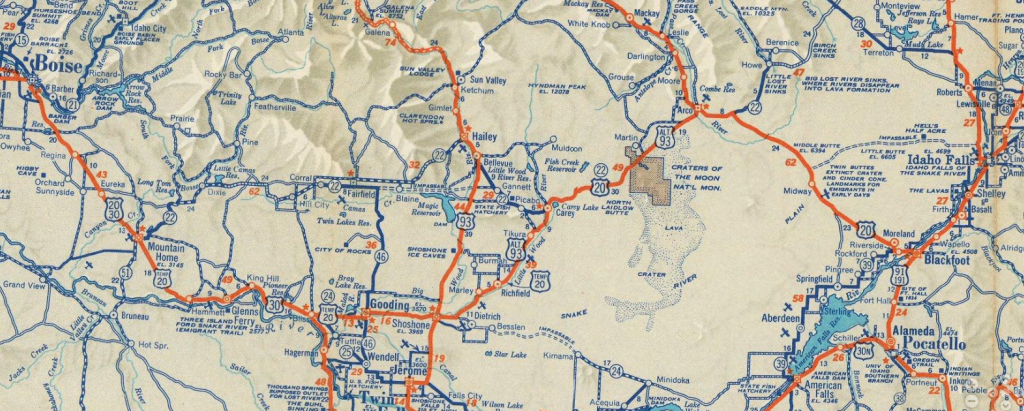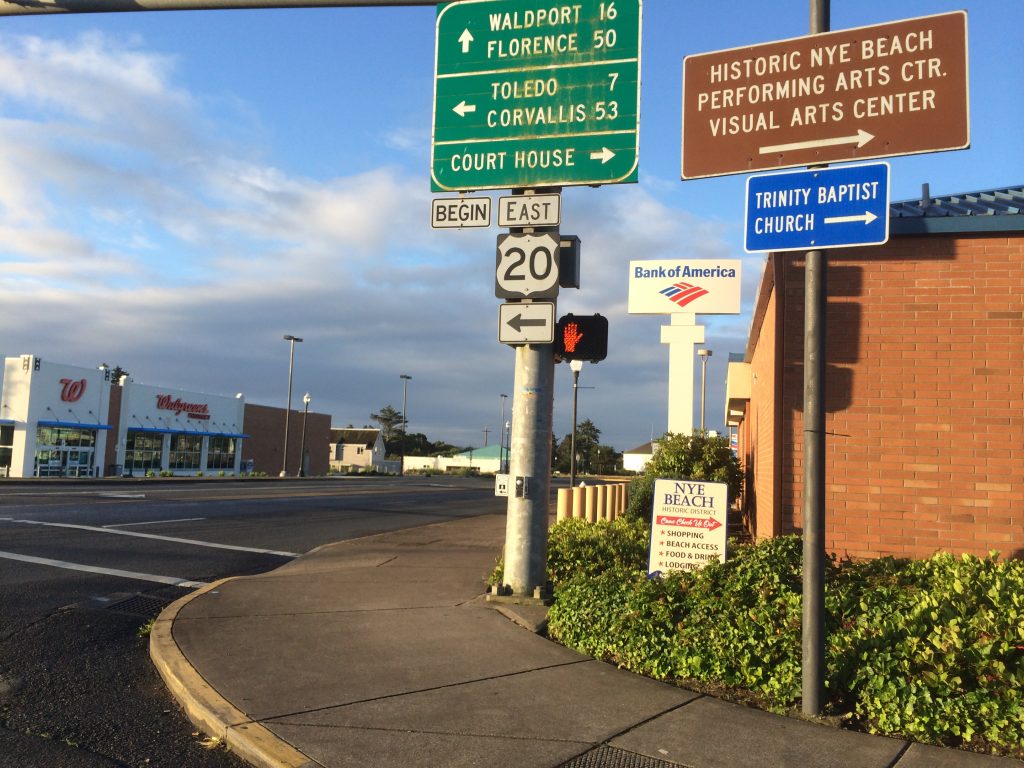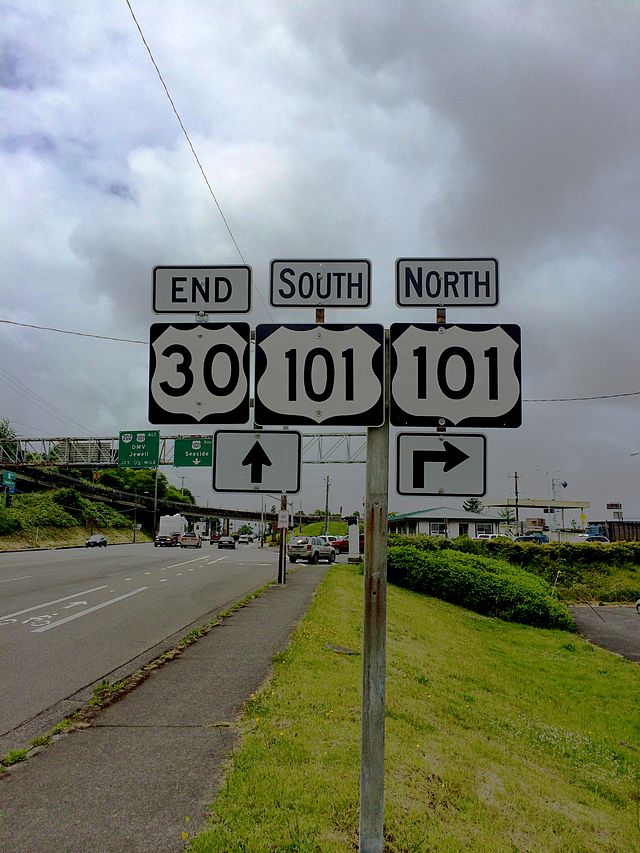Route 20: Boston to Astoria
When the route of US Highway 20 was announced in November, 1925, it was heralded as the nations coast to coast highway! A through route connecting Boston, MA to Astoria, OR!

Route 20 leads from Boston, Mass., through Springfield, Albany, Buffalo, Erie, Cleveland, South Bend, Chicago, Rockford, Dubuque, Waterloo, Webster City, Sioux City, O’Neill, Chadron, Lusk, Yellowstone National Park, Idaho Falls, Boise, Pendleton, the Dalles, Portland and to Astoria.
– Oelwein Daily Register – November 19, 1925 p1.
The process to determine which road ways would become federal highways started with the Federal Highway Act of 1921. Simply stated, this allocated federal dollars (around 7%) to improve certain state roads. It would be several years until it was determined how to make this happen. In the late Spring of 1925, states met regionally to nominate their best roads to become federal highways. For example, “the Boston to Albany route” would be nominated. It would not be until August 2-5 that representatives from all regions would meet in Washington DC to connect the dots.
Connecting the Dots
Deeming the task to connect the roads a bit much to complete in 3 days, a subcommittee was formed to make a map of the proposed routes. The most significant outcome of the August meeting were:
- The Uniformed System of Highways
- Federal Shields would be used to indicate US Highways
- State Name
- US
- Numbered Routes
- Beginning with the lowest in the north and east
- Ending with the highest in the south and west
- All previous Auto Trail names would become secondary and their markings limited
- Road sign clutter on US Highways removed
- Routes running east and west would be even
- Routes running north and south would be odd
- Transcontinental routes would end in zero
- Border to Gulf/Mexico would end in one
- Federal Shields would be used to indicate US Highways

On or around November 18, 1925 – the announcement was made on what roads would become federal US Highways. The states though had one year to amend, suggest changes or reject the plan.
Objection!
The state of Oregon objected quite quickly. On December 30, 1925, the Oregon Highway Commission wrote:
- Route 20 makes a long detour north through Yellowstone National Park
- then continues south to Pocatello and then continues to Astoria via the Columbia River
- many sections of this planned route are unimproved
- the road through Yellowstone is only open 6 months out of the year
- there is a fee to enter Yellowstone
- Oregon suggested that Pocatello be the END of US Route 20, which Wyoming and Idaho concurred.
The State of Oregon in conjunction with Idaho and Wyoming proposed a new plan.
- Favored extension of Route 30 from Granger, WY to Astoria
- Route 30 was a more southern route and was topographically suitable
- The Columbia River Route would be open year round
- The proposed route follows the Oregon Trail, Union Pacific Railroad
US Route 30 was originally intended to follow the much of the old Lincoln Highway but start in Atlantic City and terminate in Salt Lake City.
Number 30 leads from Atlantic City, Philadelphia, Pittsburgh, Canton, Ft. Wayne, Joliet, Clinton, Cedar Rapids, Marshalltown, Boone, Denison, Council Bluffs, Columbus, Cheyenne, Echo to Salt Lake City
– Oelwein Daily Register – November 19, 1925 p1.
Route 20 fails to reach the Pacific
In a January, 1926, meeting, the plan proposed by Oregon was approved and Route 20 would be terminated to the East Entrance of Yellowstone National Park and Route 30 would be adjusted between Granger, WY and Pocatello and then US Route 30 would be placed on the route originally planned to be occupied by Route 20 and Astoria, Oregon became the end of US Route 30.
In 1937, Idaho and Oregon developed a plan to bring US Route 20 through Idaho and back to Oregon. The proposal would follow the present alignment of US Route 20 to end at Bend, OR. This proposal was rejected due to insufficient improvements on certain sections in Oregon and roads not yet built in Idaho.
When the plan was redeveloped in 1940, it was approved on June 3. This redevelopment did take into consideration incomplete road sections in Idaho, placing 20 on Temporary alignments until the roads could be completed. Some of these roads, took until the 1970s to complete! Route 20 would now be extended from West Yellowstone, MT to Albany, OR.

The Conundrum
The purpose of a Uniformed System of Highways was to have the routes be concise, not concurrent and follow the rules of order (lowest north and east, highest south and west). When Route 20 was made official on September 4, 1940 in Idaho and Oregon, maps showed the intended route and the temp route. The intended route was mostly incomplete roads.
But for all intents and purposes, US Routes 20 and 30 were to officially meet in Mountain Home, ID and run together through Boise and split just outside of Caldwell, ID.

While consideration was made to not violate the north-south pattern, the American Association of State Highway Officials decided that by 1940, most people traveling did not care if the roads were out of order and that only the correct signs were in place. Therefore that is why today US Route 30 runs north of US Route 20.


US Route 20 finally completed its original reach to the coast on May 19, 1943.


My son and daughter are in the last stages of completing Hwy 20 from Newport to Boston in 80 hours. Didn’t care for Iowa (almost hit a deer and ended their journey), Illinois (rough and unmarked lanes) and Ohio (25 mph and to much construction). They are having a great time though.
We followed this route from Boston to Newport in 2018, using Brian’s book and copies of his unfinished maps which he kindly provided. Did not miss a single inch of the original route. Even drove east to Boston from Schenectady, NY to begin at the beginning.
Astoria? Highway 20 ends in Newport, OR. I live not far from there and work in Newport. It is on my bucket list to drive the longest Hwy in the US, I’ve pretty much grown up along this road. Thanks for all you do!!
I think this is meant to be a history of US highways and Route 20, dating back to 1925, not intended to state the route ends in Astoria. Astoria is part of that history. I’m planning this trip now and excited, I’ve never been to OR and plan on seeing Newport before I start my trek.
I have lived in the Corvallis/Albany area of Oregon for 57.5 years! It was in the late 60s early 70s that I realized Highway 20 went all the way east to Boston. I started dreaming of a road trip from Newport, Oregon through Corvallis/Albany to Boston! My wife did not share this dream, as she preferred to fly rather than drive! So the road trip idea was put on hold for decades! She passed away four years ago, just after celebrating our 50th wedding anniversary! I am doing research and planning the road trip to happen very soon! I am glad I found this website.
I initiated the Medal of Honor Highway Across America on U.S. Hwy 20 seven (7) years ago. Each of the 12 states along the highway adopted laws designating state Medal of Honor Highways the first being the 451 mile Oregon Medal of Honor Highway, All 12 states have dedicated state Medal of Honor Highway signs displaying the 3 versions of the Medal of Honor medal along the 3,365 mile historic highway- almost 100 signs total. Collectively the 12 states honor about 60% of our nation’s 3,519 Medal of Honor recipients from all 50 states. At my request, the U.S. Congress is in the process of designating U.S. Hwy 20 as the “National Medal of Honor Highway” honoring all 3,519 recipients from all 50 states and all future recipients of our nation’s highest award for valor. There are only 60 Medal of Honor recipients living in our nation today,
I live in Bend, OR and initiated the Medal of Honor Highway Across America on U.S. Hwy 20 seven (7) years ago. Each of the 12 states along the highway adopted laws designating state Medal of Honor Highways the first being the 451 mile Oregon Medal of Honor Highway, All 12 states have dedicated state Medal of Honor Highway signs displaying the 3 versions of the Medal of Honor medal along the 3,365 mile historic highway- almost 100 signs total. Collectively the 12 states honor about 60% of our nation’s 3,519 Medal of Honor recipients from all 50 states. At my request, the U.S. Congress is in the process of designating U.S. Hwy 20 as the “National Medal of Honor Highway” honoring all 3,519 recipients from all 50 states and all future recipients of our nation’s highest award for valor. There are only 60 Medal of Honor recipients living in our nation today,
Would the Historic Route 20 Association be interested in helping dedicate the 3,365 mile National Medal of Honor Highway across the USA on U.S. Hwy 20 next year?
If so, please contact me.